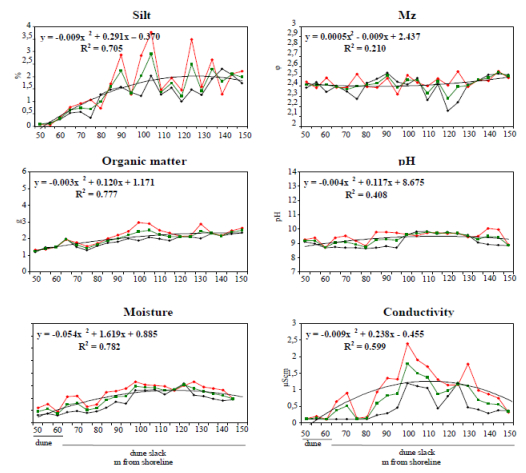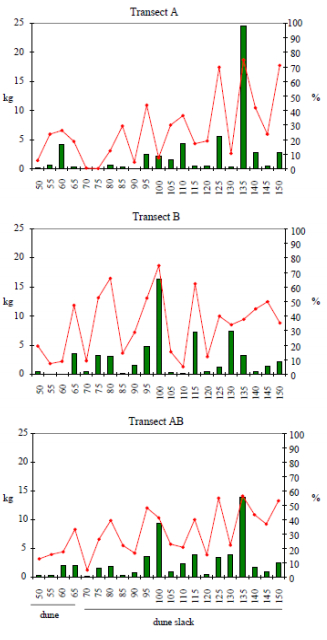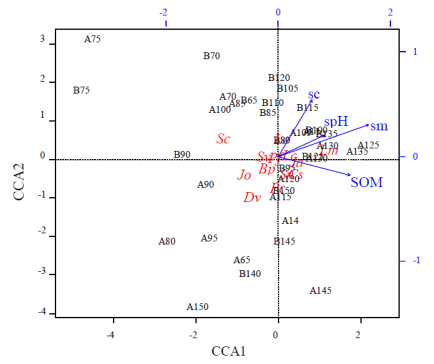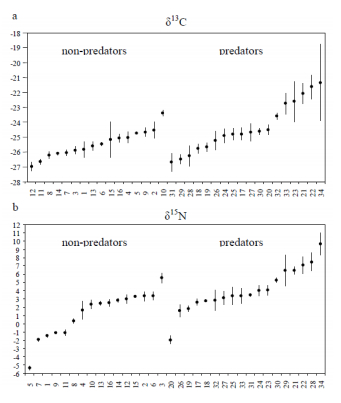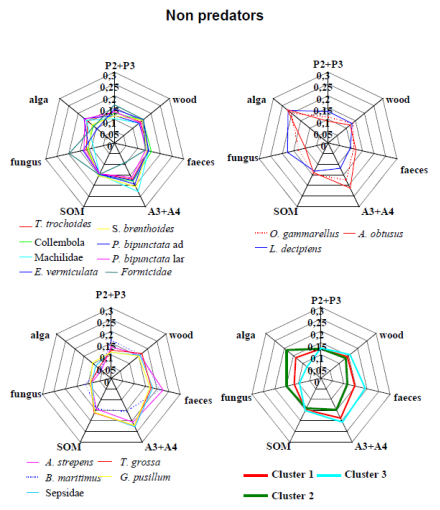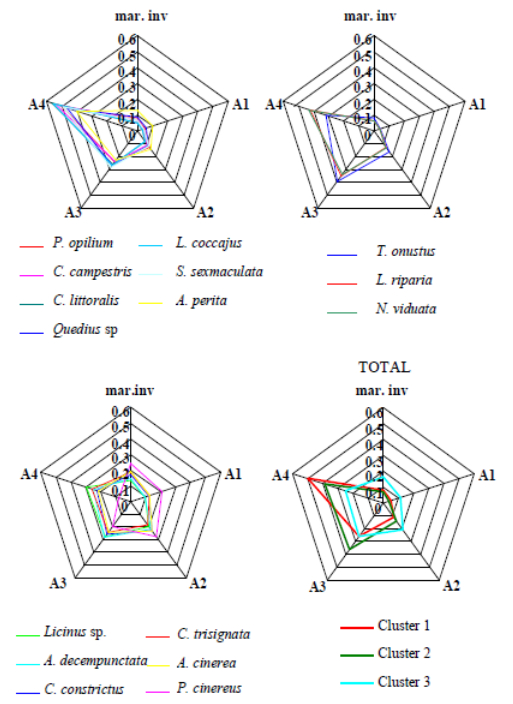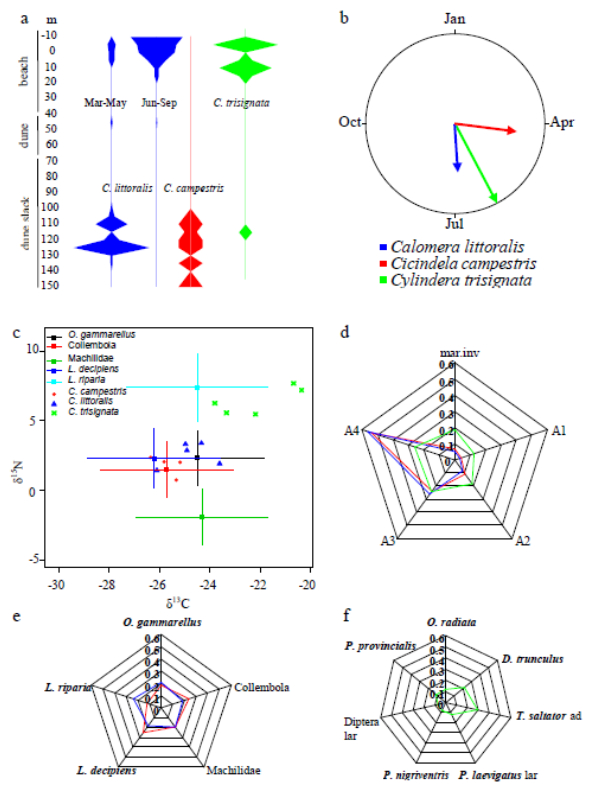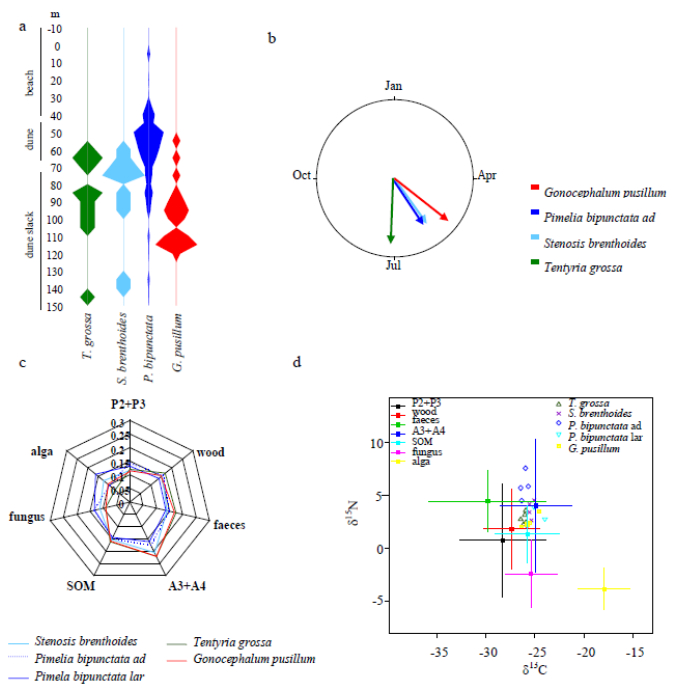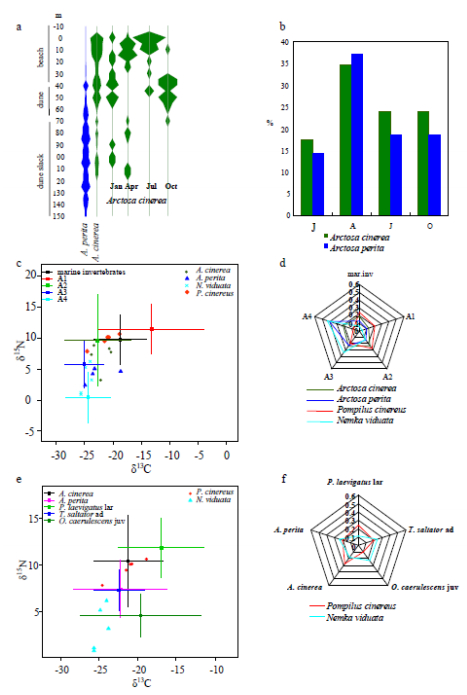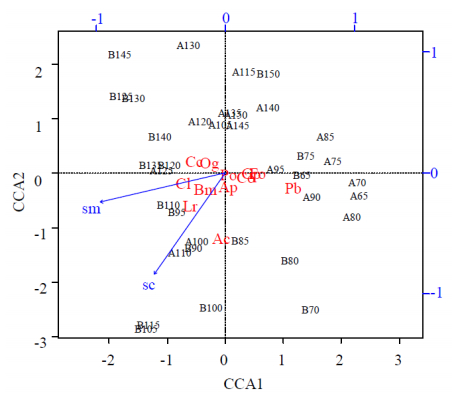1. Introduction
Dune slacks are seasonally flooded humid depressions between dune ridges, and are a priority habitat for rare species of conservation importance. They are mainly established in two ways: as primary slacks, when bare sand is disconnected from seawater influence by the formation of a newly developing dune ridge, or as secondary slacks, when sand is blown out until groundwater level in the inner parts of a dune area [1]. One of the most distinctive features of dune slacks is a seasonal fluctuation of the water table, which controls slack vegetation development. Variation of water levels occurs within the year, typically around 70 cm with a rapid rise in autumn and a gradual decrease from spring to summer [2].
Young dune slacks are nutrient-poor but show a large variability with respect to species composition, which reflects the characteristics of the groundwater regime [3]. Basiphilous pioneer communities in dune slacks are typically restricted to environments of a very low nutrient status, particularly regarding nitrogen and phosphorus [4]. Regarding the specific basiphilous character of dune slack habitats, it was hypothesized that pH dependent mechanisms [5,6] maintain a low nutrient availability by fixation of phosphates [7]. Carex flacca [8] and Schoenus nigricans [9] that are present in early stages and generally require low phosphorus, support this hypothesis. In later successional dune slack stages, where pioneer species have disappeared, a large proportion of phosphorus (ca. 70%) is organically bound [10,11], and there is a dominant acidophilous plant community with an increase of tall grasses and shrubs. Grootjans et al. [12] suggested that the considerable decline of basiphilous species in a large dune slack complex was related to the processes of acidification and organic matter accumulation in the low-lying wet parts, but also to decalcification in the drier parts. Groundwater chemistry is another factor controlling plant distributions [13] and this depends to a great extent on whether it is precipitation fed, as in an isolated dune system [14] or externally derived.
Many species are endemic to these systems, and have recently been threatened by natural and anthropogenic impacts such as ground water abstraction, urbanisation, afforestation, irrigation, production of drinking water and various other activities that lower water tables in adjacent areas [3,15,16]. An emerging threat is climate change which predicts sea-level rise. Sea-level rise as a consequence of global warming could either lead to a drop or a rise in the groundwater level, depending on erosion and accretion rates along the coastline.
The importance of dune slack habitats as a priority habitat (Nature 2000: 2190 Humid dune slacks) has been pointed out by many authors especially in Northern Europe where many projects have aimed to restore and produce guidelines for managers [17,18,19,20,21]. The percentage distribution of the total surface of humid dune slacks reported in Nature 2000 for these counties is of 25–27% whereas for Italy it is only of 4–7%. This might be the reason why these habitats have received little attention and most of the existing literature is focused on the vegetation communities [22], their transition towards woody environments [23,24] and on their response to disturbing factors [25,26]. Mazzotti [27] had recognized dune slack habitats and ponds as important areas for fresh water turtles (Emys orbicularis) whereas few works have been made on beetles and other terrestrial invertebrates. On British saltmarshes Hammond [28] summarised the known information about ground and rove beetles (Staphylinidae), whilst Good [29] considered both groups on Irish sandflats. Eyre and Luff [30] went on further attempting to identify ground, rove and phytophagous species assemblages and to explain some of the environmental factors influencing the distribution of these assemblages. In Italy an effort was made by Colombini et al. [31] that considered dune slacks as important habitats in beach dune ecosystems and carried out a preliminary assessment of the food webs of beach macroinvertebrates including those of some dune slack species. The present study aims to further analyse the environmental characteristics of dune slacks within a Mediterranean beach dune system focusing attention on the macroinvertebrate community. The main questions that were addressed were whether dune slacks had invertebrate species strictly tied to the slacks or if there were some species exploiting the area in relation to certain seasons or to specific periods of their life cycle. Furthermore, for the first time, an attempt was made to highlight the food links of species belonging to different guilds of a dune slack using a stable isotope analysis, a method known to be useful to understand fundamental processes in the biology and ecology of arthropods [32].
2. Materials and Methods
2.1. Study Site
The dune slack chosen for the study was located on a sandy beach dune system at 6 km to the south of the Ombrone river mouth (42°37'52.8"N, 11°4'42.3"E) (Figure 1). The beach was exposed (exposure rate = 12 [33]; for rating scheme see [34]) and consisted in a wide, flat eulittoral (non-vegetated zone) and a supralittoral with the first pioneer plants (40 m in width). This was followed by a shifting mobile dune (1.10 m in height) covered by Ammophila arenaria (white dune) and a dune slack, a low lying depression between the first and second dune belt characterised by a typical dune slack vegetation (dominated by Juncus acutus and Schoenus nigricans). This dune slack was classified as Type B according to the hydrological and hydrochemical conditions of humid dune-slacks [18]. This area was characterised by the presence of surface water that occurred occasionally according to heavy rains and was flooded by sea water during winter storms. The wet area thus varied from 65 m to 150 m (from the sea) during floods but then tended to become more restricted as the season changed.
2.2. Sampling Procedures
From October 2006 to September 2007 an ecological study was carried out at the selected site. To capture terrestrial macroinvertebrates two line transects, at a 25 m distance, were set perpendicularly to the shoreline and proceeded landwards for 150 m to the back dune up to the pinewood vegetation. Each transect consisted of 31 pitfall traps set at a 5 m interval from which fauna samples were collected during four seasons (October, January, April, July). For coleopterans monthly samples were taken. Macroinvertebrates were then counted and identified to species level. Qualitative and quantitative assessment of the vegetation was carried out in the four different seasons using quadrats (50 × 50 cm) of above-ground vegetation. Samples were taken externally from the two transects and parallel to the shoreline at 1 m (October), 2 m (January), 3 m (April) and 4 m (July) distance from the pitfall traps. For this work vegetation samples were considered only from 65 m to 150 m because this corresponded to the maximum extension of the dune slack area. Once identified all plants were cut from the surface and stored in plastic bags. In the laboratory the vegetation was weighed after oven drying at 70° until constant weight. For each sampling station an annual mean plant biomass, expressed in dry weight per kg per square meter (dw kg−1 m−2) was calculated pooling data from quadrats of the four seasons. This was done to characterise each sampling station for its vegetation and to see if macroinverterate composition was influenced by plant biomass (see Canonical Correspondence analysis). During sampling periods the chemical and physical characteristics of the soil (moisture, pH, conductivity, organic matter, grain size, silt content) were also collected. For environmental sampling procedures and list of plant species see Colombini et al. [31,35].
2.3. Collection of Species and Trophic Sources. Laboratory Procedures for Stable Isotope Analysis.
For stable isotope determination terrestrial macroinvertebrates were collected from the pitfall traps whereas fliers associated to the vegetation were caught using hand nets. Only for some insect species both larval and adult stages were examined because both occurred in the pitfalls. Of the intertidal fauna only three species (Ophelia radiata, Donax trunculus, Euryidice affinis) and seston were collected to assess the possibility of marine components entering the terrestrial food web.
All captured species were kept alive for 24 h to allow gut evacuation and then were frozen at −20° and dried at 70° until constant weight. Plants of the dune slack were collected to assess their importance in the food web. For isotopic analysis the most abundant vascular plants were chosen and only green leaf material from five individuals of each species was used. To assess sand parameters and sediment organic matter (SOM) surface sediment samples (up to 10 cm in depth) were collected at 70 m, 90 m, 110 m, 130 m and 150 m. The sand was dried and sieved with an automatic shaker using sieves with meshes up to 63 μm. For the algae Chlorophyceae were chosen as a potential food source as they constitute the epiphytic algae growing on decomposing leaves and on the lower parts of J. maritimus in salt marshes [36] and in the dune slack areas [37]. In this case the terrestrial green algae Chlorococcum infusionum was chosen. For the fungus species Cladosporium cladosporioides was selected because it was the most abundant species at spring time at the site [38,39]. Fallow deer and cow faeces were also chosen because these were heavily present in the area.
For each macroinvertebrate and plant species, 5 individuals were separately ground with mortar and pestle and two replicates were made from each individual. The elimination of carbonates by acidification prior to isotopic analysis was considered for marine derived macrophytes and animals, intertidal crustacean species and SOM [40,41]. Non-acidified aliquots were used for δ15N determination. Subsamples were then individually oxidised in a Carlo Erba 1110 elemental analyser (Carlo Erba Instruments, Milan, Italy) coupled to a Finnigan Delta Plus mass spectrometer. Isotope ratios (δ13C,
δ15N) in per mil (‰) were obtained using this formula: δsample
= [(Rsample/Rstandard) − 1]·1000 (R = 13C/12C, or R = 15N/14N). The δ values reflected the ratio of heavy and light isotopes in the samples compared with standard reference materials, namely Vienna PeeDee Belemnite (PDB) carbonate and atmospheric air nitrogen.
2.4. Statistical Analysis
For the environmental parameters of the dune slack area mean annual values were computed for each pitfall location of the two transects. Regression equations were calculated on these mean values to check if certain trends occurred along the beach-dune-dune slack axis. Environmental data were employed also for Canonical Correspondence Analysis (see below).
For food sources hierarchical cluster analysis was applied using δ13C and δ15N of the different species. Macroinvertebrates and plants were pooled into four (A1, A2, A3, A4) and three groups (P1, P2 and P3) respectively [31]. For both non-predator and predator species hierarchical cluster analysis was used to group species with similar isotopic signatures. For non-predator species each group was then tested with seven food sources and with five for predator species.
A Bayesian stable isotope mixing model (SIAR, [42]) was employed to obtain the relative contribution of the different food sources to the diets of the macroinvertebrates. For each source a mean value was calculated. To investigate the role of each item as food sources mean values were adjusted by the appropriate trophic enrichment value (fractionation values of 0.39‰ for δ13C and of 3.4‰ for δ15N according to Post [43].
Canonical Correspondence Analysis (CCA) was used to evaluate the effect of the environmental parameters of the dune slack on the vegetation structure and macroinvertebrate composition. Plants and macroinvertebrates were log-transformed. The following parameters, soil moisture, pH, conductivity, sediment organic matter, grain size (Mz) and silt, were considered for the vegetation structure (evaluated on a presence/absence criteria) whereas vegetation biomass (kg) and cover (%) were added when testing the macroinvertebrate composition (evaluated on their abundance and considering all traps). Eigenvalues and scores for CCA were calculated using CANOCO software, version 4.5 [44]. A forward selection procedure was used to select a subset of variables that significantly contributed to the variation in the species data for each scale of analysis.
For the three cicindelid species and some tenebrionid species circular statistics tests were used to analyse the annual component of surface activity, estimated by the number of monthly captured individuals (mean annual presence). The Rayleigh test was used to determine whether the population showed a significant preference for a certain period of the year [45].
3. Results
The analysis of the environmental parameters showed that the dune slack area had significantly more silt and organic contents, a higher moisture, pH and conductivity compared to the dry dunes (Figure 2). Finer sands were registered from 110 m landwards. Regression equations were highly significant with R2 over 0.40 in all cases except for grain size parameter.
According to vegetation samples the two line transects slightly differed both for plant cover and biomass with transect A having a higher vegetation cover at 135 m. There wasn't a direct correspondence between vegetation cover and plant biomass in all case (Figure 3).
Canonical correspondence analysis explained approximately 26% of the variation in vegetation composition on the first four axes (Figure 4). The first axis, with an eigenvalue of 0.121, explained 13% of the variation in the vegetation assemblage and was mainly correlated with sand moisture (0.81) and with SOM (0.64). The second axis, with an Eigenvalue of 0.095, explained 10% of the variation and was mainly correlated with soil conductivity (0.54). L. etruscum was positively correlated with soil conductivity, L. maritimus mainly with SOM but also with soil moisture, pH and conductivity. Negative correlations were obtained with all parameters for D. viscosa and J. oxycedrus.
Dune slack macroinvertebrates were most abundant during summer due to the presence of Collembola and Hymenoptera and species richness peaked during springtime (Table 1). δ13C and δ15N calculated through stable isotopic analysis for macroinvertebrate species are shown for two different guilds (Figure 5). Non predator species included primary consumers and scavengers with the highest trophic level being represented by adults of the tenebrionid Pimelia bipunctata and the lowest by the Machilidae gen, sp. Note that predators had only a few species with trophic levels higher than those of non-predators. The same can be said for δ13C values. Cluster analysis grouped non-predator species in three clusters with a 50% dissimilarity level (Figure 6). Cluster 1 included the mollusc Trochoidea trocoides, the tenebrionid Pimelia bipunctata larvae, Pimelia bipunctata adults, the mollusc Eobania vermiculata, the bristletail Machilidae gen. sp., the tenebrionid Stenosis brenthoides, Collembola gen. sp. and Formicidae gen. sp. Cluster 2 include the amphipod Orchestia gammarellus, the isopod Agabiformis obtusus and the cockroach Loboptera decipiens. Cluster 3 included the tenebrionids Gonocephalum pusillum, Tentyria grossa, the grasshopper Aiolopus strepens, the heteropteran Beosus maritimus and the scavenger fly Sepsidae gen. sp. In cluster 1 the Bayesian stable isotope mixing model (SIAR) showed that the mean contribution of the seven food sources was more or less even for all invertebrates except for the bristletail Machilidae gen. sp. to which A3 + A4 (dune and retrodune macroinvertebrates) contributed almost 23% and for the Formicidae gen. sp. who's highest food item was the fungus (19%). In cluster 2 algae and A3 + A4 contributed 17% and 20% to the amphipod's O. gammarellus diet and 20% and 22% to that of the isopod A. obtusus. In Cluster 3 A. strepens, B. maritimus mostly fed on cow and deer faeces whereas G. pusillum, T. grossa and the Sepsidae gen. sp. mainly fed on A3 + A4 with only slight variations from 21% to 23%.
Table 1. Capture numbers of dune slack invertebrates shown for the main orders in the different seasons and on the total. The number of specimens is shown associated to the species number.
| n Specimens/n Species |
| Order |
Winter |
Spring |
Summer |
Autumn |
Total |
| Amphipoda |
107/2 |
135/1 |
21/1 |
570/2 |
833/2 |
| Araneae |
53/18 |
255/29 |
62/19 |
119/24 |
489/52 |
| Coleoptera |
27/19 |
264/37 |
40/20 |
103/21 |
434/60 |
| Collembola |
111/6 |
445/8 |
2035/3 |
25/3 |
2616/10 |
| Dermaptera |
– |
7/1 |
24/1 |
32/1 |
63/1 |
| Diptera |
14/9 |
44/13 |
18/8 |
19/5 |
95/23 |
| Hemiptera |
3/3 |
100/11 |
26/6 |
4/3 |
135/14 |
| Polmonata |
– |
– |
– |
20/2 |
20/2 |
| Hymenoptera |
7/2 |
653/11 |
954/6 |
12/4 |
1626/16 |
| Isopoda |
– |
11/4 |
19/5 |
45/3 |
75/6 |
| Opiliones |
107/8 |
129/8 |
11/4 |
54/5 |
301/8 |
| Others |
46/2 |
44/17 |
26/11 |
8/7 |
124/32 |
| Total |
475/69 |
2087/140 |
3238/84 |
1002/80 |
6802/226 |
For predator species (Figure 7) hierarchical cluster analysis segregated three groups at a dissimilarity level of 30%. Cluster 1 included the harvestmen Phalangium opilium, the owlfly Libelloides coccajus, the tiger beetle Cicindela campestris, the wasp Scolia sexmaculata, the tiger beetle Calomera littoralis, the spider wolf Arctosa perita and the staphylinid Quedius sp. Cluster 2 included the spider Thomisus onustus, the earwig Labidura riparia and the velvet ant Nemka viduata. Cluster 3 grouped the carabid Licinus sp., the tiger beetle Cylindera trisignata, the ladybug Adalia decempunctata, the spider wolf Arctosa cinerea, ant-like flower beetles Cyclodinus constrictus and the wasp Pompilus cinereus. SIAR analysis showed that predators of Cluster 1 had diets including more than 40% of retrodune macroinvertebrates (A4). Predators of Cluster 2 mainly included macroinvertebrates of the dune (A3) and retrodune (A4) to their diets with a contribution of more than 70% whereas predators of Cluster 3 showed that the contribution of the five food sources was more or less the same with slightly higher values (20–30%) for macroinvertebrates of A3 and A4. All these results became even more evident when the means for each cluster were tested with the five food sources (Total in Figure 7). The three sympatric cicindelid species were studied both in space and in time (Figure 8a and 8b). The results indicated a spatial segregation among the species with adults of C. littoralis occupying from 110 m to 130 m during spring and from the shoreline to 15 m on the eulittoral in summer. C. campestris occurred in the dune slack area at all times, whereas C. trisignata was mainly found on the beach from 0 m to 20 m (Figure 8a). Furthermore, Circular statistic analysis showed that there was a temporal segregation in the appearance on the littoral with C. campestris (Rayleigh test n = 13, z = 6.08, p < 0.002) appearing at the end of April followed by C. trisignata (Rayleigh test n = 12, z = 12.00, p < 0.001) at mid-June and by C. littoralis at the beginning of July (Rayleigh test n = 217, z = 68.11, p < 0.001) (Figure 8b). The analysis of stable isotopes showed lower mean trophic levels for C. campestris (δ15N = 1.89) and C. littoralis (δ15N = 2.60) compared to C. trisignata (δ15N = 6.44) which also had a higher mean δ13C value (−22.08) (Figure 8c). The preliminary analysis of the diets with 5 food sources (marine invertebrates, A1–A4) of the three cicindelid species (Figure 8d) showed that A4 macroinvertebrates contributed 56% and 54% to the diets of C. littoralis and C. campestris respectively while only 22% to that of C. trisignata. A more in-depth analysis testing the diets of C. littoralis and C. campestris with five specific food items (O. gammarellus, Collembola gen. sp., Machilidae gen. sp., L. decipens and L. riparia, all macroinvertebrates of the dune slack area, Figure 8e) showed very similar contributions of the different sources with values ranging from 12% to 25%. Instead a different spectrum of seven food sources of invertebrates all inhabiting the beach area, was proposed to C. trisignata (Figure 8f). In this case the amphipod T. saltator contributed almost 30% to the diet of this species and D. trunculus, a mollusc frequently found stranded on the shore, almost 21%. In Appendix A the proportion contributions of the different food items are shown for the three cicindelid species.
The same type of analysis was conducted for the most important tenebriond species of the study area. Spatial analysis (Figure 9a) showed that T. grossa and S. brenthoides occupied areas only marginally interested by floodings, P. bipunctata occurred both on the dune and the retrodune, while G. pusillum extended its zonation pattern up to the dune slack. Circular statistic analysis showed a temporal segregation for G. pusillum which had a mean value of occurrence at the end of May (Rayleigh test n = 20, z = 15.44, p < 0.001) and for T. grossa a mean value at mid-July (Rayleigh test n = 11, z = 7.71, p < 0.001), while the other two species had a mean occurrence at the beginning of June (Rayleigh test P. bipunctata n = 220, z = 111.42, p < 0.001; S. brenthoides n = 12, z = 6.12, p < 0.002) (Figure 9b). With SIAR analysis seven hypothetical food sources (P2 + P3, wood debris, faeces, A3 + A4, SOM, fungus, algae) were tested to assess the diets of the four tenebrionid species. In most cases the food source A3 + A4 contributed from 20% to 22% to the diets of the tenebrionids and only in the case of the larvae of P. bipunctata similar contributions from all seven food sources were assessed (Figure 9c). Biplots (Figure 9d) showed the highest δ15N range (4.5 to 7.6) for adults of P. bipunctata but similar δ13C values when compared to the other tenebrionid species.
Appendix B reports the proportion contributions of the different food sources for the tenebrionid species.
Another interesting group of predators was represented by the two lycosid spiders Arctosa perita and Arctosa cinerea, the wasp Pompilus cinereus and the velvet ant Nemka viduata. Since the two spiders were contemporaneously present on the littoral during the different seasons the two species adopted a clear spatial segregation (Figure 10a). In fact A. perita generally occurred on the dune and in the retrodunal areas (mean zonation = 88.1 m) while A. cinerea occupied a wider range but mainly inhabited the beach areas (mean zonation 51.0 m). From a more accurate study it emerged that A. cinerea was found in the dune slack area especially during winter-spring months while in summer and in autumn this species definitely occurred in more seaward areas.
The general assessment of the different food sources (5 items) tested for the two wolf spiders and the two hymenopterans indicated that A. perita and N. viduata had 40% and 43% of contribution by the A4 item. A larger variety of food sources entered in the diets of the other two species without any particular preference for any specific food item (Figure 10c and 10d). As for the two hymenopterans SIAR was tested to assess their diets and in this case, according to the literature [46,47] in which Lycosidae are known to be preyed on by P. cinereus, also the two wolf spiders were used as food items together with larvae of P. laevigatus, adults of T. saltator, juveniles of O. caerulescens. A.
cinerea and P. laevigatus contributed 27% and 23% respectively to the diet of P. cinereus, whereas A. perita and T. saltator were equally included up to 50% in the diet of N. viduata (Figure 10e and 10f). In Appendix C the proportion contributions of the different food items are shown for the two spiders and the two hymenopterans.
Canonical correspondence analysis used to assess dune slack macroinvertebrate composition showed that the first two axes explained approximately 39% of the variation (Figure 11). The first axis, with an Eigenvalue of 0.233, explained 32% of the variation while the second axis, with an Eigenvalue of 0.052, explained 7%. The first axis was negatively correlated with soil moisture (−0.97) whereas the second axis with soil conductivity (−0.84). L. riparia was positively correlated with soil moisture and conductivity, A. cinerea mainly with soil conductivity while C. littoralis mainly with soil moisture. The two tenebrionid species P. bipunctata and G. pusillum were mainly negatively correlated with soil moisture.
4. Discussion
The results of the study indicate that the dune slack is a particular area of the beach-dune ecosystem with continuously changing environmental conditions to which the macroinvertebrate fauna have adapted with different behavioural and life cycle strategies.
The dune slack analysed was in its early stage, phase 2 according to Sival and Grootjans classification [48].
Although the substrate parameters of the dune slack changed throughout the day and the seasons some general patterns were elucidated from the study. As compared to surrounding areas higher percentages of silt, organic matter, moisture and salt in association with basic pH made the dune slack an environment where only some plant and animal species thrived. This was the case of the endemic plant Limonium etruscum that was found strictly associated with high concentration of substrate salinity and of the amphipod Orchestia gammarellus, a typical resident dune slack species that conducted its entire life cycle in the area. Previous studies [49] had, in fact, demonstrated that the species was well adapted to the continuous changes in the microhabitat conditions by actively modulating its behaviour and changing type of refuges as the season dried up. Furthermore the present study showed that the species was mainly a scavenger and that algae and other organic debris belonging to the A3 + A4 group of invertebrate species of the dune slack and retrodune areas made up almost 40% of its diet.
This study also showed that the invertebrates were clearly subdivided in two main guilds: non-predator and predator species as indicated by the levels of the δ15N values registered. Based on the isotope values of the different species, hierarchical cluster analysis grouped similar species in clusters and then were tested with the available food sources. General detritivorous or scavenger species with very low preferences for certain food items (see results of SIAR) were grouped in Cluster 1, amphipods and isopods preferring algae and other items of A3 + A4 were grouped in Cluster 2, whereas tenebrionids and grasshoppers respectively feeding on A3 + A4 and on cow dung were put together in Cluster 3. The same type of observation can be done for predator species where species with similar preferences for specific food items were grouped in the same cluster reaching, in some cases, over 50% of the contribution in the diets of the singular species. This suggests that both in the case of predator and non-predator species there is a specific segregation in the use of food items that in some way can be categorized according to the species and that the dune slack area can be exploited by specific species as a feeding ground.
Tiger beetles are known worldwide to occur on flat, sun exposed areas surrounded by halophytic vegetation [50,51,52,53,54], and being visual predators they need bare grounds to hunt [55]. The present study clearly showed that the dune slack was exploited in different ways by the three tiger beetle species of the Cicindelidae family. All species were free running active predators and different spatial and temporal strategies were adopted according to the species: Cicindela campestris was the first to appear and conducted its entire life cycle in the dune slack area mainly feeding on juveniles of Loboptera decipiens. Cylindera trisignata, appearing later on in the season, mainly occupied the eulittoral and fed on T. saltator while the third species, Calomera littoralis, had an intermediate behaviour, conducting its larval phase in the dune slack area, emerging and exploiting the area during spring time and then shifting to the beach zone during summer months. This also reflected the intermediate values in the isotopic signatures of both δ13C and δ15N that occurred for C. littoralis. Rodríguez-Flores [56] in their study on C. littoralis had detected shifts in the occupied sites which followed the retreat of water during the continuous drying-out of lakes and pools. Like in our case the authors found that the species was frequently associated with C. campestris. The three species thus seem well adapted to their environment avoiding competition through spatial, temporal and food segregation. Spatial segregation of tiger beetles based on habitat structure has been frequently reported in previous studies [53,54,57,58,59], suggesting that our findings are quite common for the Cicindelinae family.
As regards to thermophilic darkling beetles, these frequently occurred on bare substrates which offered significantly warmer and drier conditions than surrounding areas of vegetation [55] and were likely to inhabit dune slack areas [20]. Of the four species here analysed T. grossa, S. brenthoides and P. bipunctata only marginally occupied the dune slack area although the most searched food items belonged to the A3 + A4 group, whereas G. pusillum preferred the dune slack area in relation to its preference to high pH values of the substrate [60]. Also for these beetles there was a clear temporal segregation between adults of T. grossa and P. bipunctata which appeared to be in competition occupying similar habitats and presenting a similar trophic spectrum (see δ13C values). A clear temporal segregation on a daily basis had already been pointed out between the two species by Fallaci et al. [61] which demonstrated morning and evening peaks of activity for T. grossa and a diurnal activity concentrated around noon for P. bipunctata. Mark-recaptured methods showed that these two species were highly mobile, roaming on the dunes and in the retrodunal area in search of seeds produced by heat-and drought-stressed plants which in many cases are more floriferous making them more attractive to invertebrates [55]. Colombini et al. [31] in a previous study showed that adults of P. bipunctata had contributions in their diets of almost 92% from plants such as Euphorbia peplis, or graminacea such as Erianthus ravennae and Sporobolus pungens known for their high production of seeds.
Solitary bees, wasps and spiders are warmth-loving species and coastal sand dunes represent particularly favourable environments especially for underground nest construction [55]. Our study pointed out the spatial segregation of the two psammophilous spiders,
Arctosa perita and Arctosa cinerea, the first mainly occupied the dune and retrodunal areas all year round whereas the second, only occasionally, during winter-spring months. Framenau et al. [62] showed that females of A. cinerea tend to move away from the water prior to brood care and to hibernate in areas less likely to be flooded during the winter [63]. Pitfall trapping showed that females of A. cinerea carrying juveniles were caught in April in areas far from flooding confirming the findings of Framenau et al. [62]. The spatial segregation found for the two spiders also determined a clear distinction in prey selection with a higher specificity of A. perita for preys of the A4 group such as amphipods (O. gammarellus), snails (Trochoidea trochoides) and juvenile cockroaches (Loboptera decipiens).
As for the two predacious wasps, the spider-hunting Pompilius cinereus specifically selected A. cinerea as prey, on which to deposit its egg. In fact after capture, the wasp excavates a burrow to which the prey is carried in, and on which it deposits its egg [64]. Stable isotope analysis clearly showed that the wasp incorporated spider tissues in its teguments at the larval phase reaching 27% of contribution. A significant contribution to the diet of the wasp was also given by the larvae of carabid Parallelomorphus laevigatus which are diurnal [65] contrarily to the adults that are nocturnal. The day activity of the larvae thus made it another good candidate for predation for P. cinereus. The isotopic signature of the adult reflected what the species has incorporated during the larval phase as these holometabolous insects do not gain any additional somatic biomass as adults [66]. Another day-active wasp found near the dune slack was Scolia sexmaculata a small wasp generally found in association with the maquis vegetation between July and August [67]. Adults preferably fed on plants with composite flowers [68] and nectar was particularly important for females for egg formation [69]. The wasp parasitizes larvae of solitary hosts belonging to the Scarabeoidea Coleptera and in particular to the Rutelinae (Anisopha agricola, Anomala ausonia), Cetoniinae (Oxythyrea funesta Tropinota sp.) [68] and the Dynastinae (Calicnemis latreillei) families, living in soil or in rotting wood [70], all hosts belonging to the A4 group that can be easily found in the dune slacks. The wingless female of the velvet ant Nemka viduata, observed more inland, showed a major predation on the other spider species A. perita. To date only the digger wasps Bembecinus tridens and Stizus continuus are confirmed as hosts [71,72] even if the velvet ant has been found to be associated with various spheciforms. Although most mutillids were found to be stenophagous [73] this might reflect a poor knowledge since a few have been recorded from several disparate hosts [74]. Polidori et al. [75] found that host searching activities of N. viduata females were carried out in early morning and late afternoon hours in relation to the lower soil temperatures. Our results on the food items chosen by the velvet ant showed that the amphipod T. saltator contributed almost 24% to the wasp's diet. The amphipod's bimodal daily activity pattern [76] suggested that surface activity pattern of the wasp could also be related to the search of this particular prey.
The single species here analysed are just some examples of how dune slack habitats of sandy coastal areas are important for resident and non-resident species. Being very dynamic habitats, due to the continuous changing conditions of the substrate according to the day and season, both plants and macroinvertebrates have adopted strategies to cope with these changes. Thus some species can use slacks as nursery grounds for their larval phase and then shift to other areas as adults while others (mainly predators) can use slacks as feeding areas. Moreover dune slacks are not only fundamental but also precious habitats to guarantee a greater biodiversity within sandy beach ecosystems, environments that are now undergoing strong anthropogenic pressures and natural hazards (climate changes). In order to understand the evolution of dune slack habitats it is important not only to achieve information on the hydrological and chemical components of the system but also to gain knowledge on the plants and animals (including macroinvertebrates) that exploit the system. The integrity of the beach-dune-dune slack ecosystem becomes a key factor and the present study shows how the different compartments are linked to one another, a fact that should be keep in mind by local authorities and managers.
Acknowledgements
The research was funded by the Italian National Council of Research. We would like to thank the local authorities of the Maremma Regional Park and of the Tenuta Agricola of Alberese which authorised the study within the Park.
Conflict of Interest
The authors declare no conflicts of interest in this paper.









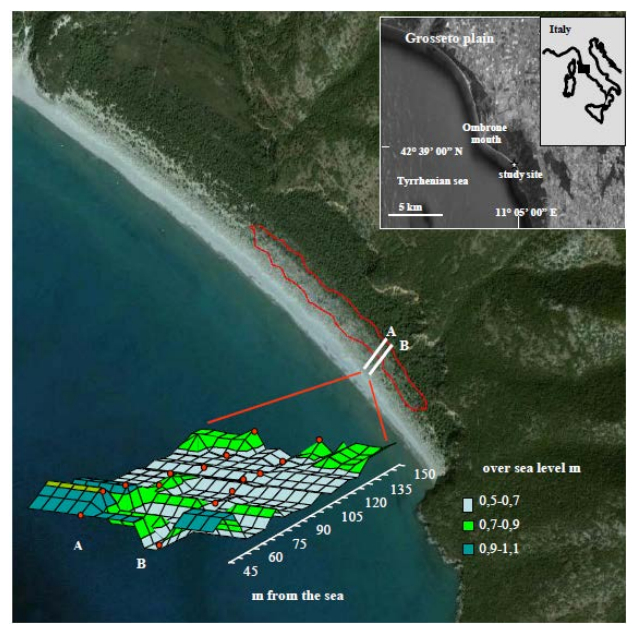
 DownLoad:
DownLoad: 